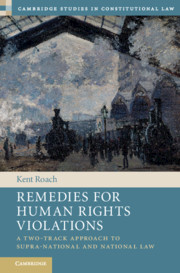Book contents
- Remedies for Human Rights Violations
- Cambridge Studies in Constitutional Law
- Remedies for Human Rights Violations
- Copyright page
- Brief Contents
- Contents
- Acknowledgements
- Table of Cases
- 1 The Importance and Complexity of Remedies
- 2 A Two-Track Approach to Individual and Systemic Remedies
- 3 Interim Remedies
- 4 Remedies for Laws That Violate Human Rights
- 5 Damages
- 6 Remedies in the Criminal Process
- 7 Declarations, Injunctions and the Declaration Plus
- 8 Remedies for Social, Economic and Cultural Rights
- 9 Remedies for Violations of Indigenous Rights
- 10 Conclusion
- Select Bibliography
- Index
2 - A Two-Track Approach to Individual and Systemic Remedies
Published online by Cambridge University Press: 29 March 2021
- Remedies for Human Rights Violations
- Cambridge Studies in Constitutional Law
- Remedies for Human Rights Violations
- Copyright page
- Brief Contents
- Contents
- Acknowledgements
- Table of Cases
- 1 The Importance and Complexity of Remedies
- 2 A Two-Track Approach to Individual and Systemic Remedies
- 3 Interim Remedies
- 4 Remedies for Laws That Violate Human Rights
- 5 Damages
- 6 Remedies in the Criminal Process
- 7 Declarations, Injunctions and the Declaration Plus
- 8 Remedies for Social, Economic and Cultural Rights
- 9 Remedies for Violations of Indigenous Rights
- 10 Conclusion
- Select Bibliography
- Index
Summary
This Chapter responds to the under-theorization of remedies by outlining and defending the two-track approach that combines individual and systemic remedies with courts playing a more dominant role with respect to the former and a more dialogic role with respect to the latter. Part I examines the roots of compensatory remedies in corrective justice and “right to a remedy” reasoning associated with the common law and Blackstone and Dicey. Part II examines how remedies have increasingly been concerned with preventing future rights violations. Part III outlines the two-track approach and explores its origins in the distinction that supra-national adjudicators often draw between individual and general measures and Chayes’ distinction between traditional and public law litigation. Part IV argues that an exclusive focus on either individual or systemic remedies will be incomplete and produce remedial pathologies. Part V examines how the two-track approach recognizes and responds to the reality of remedial failure. It outlines how cycles of individual and systemic remedies can occur. This allows both litigants and courts to adjust their approach in response to new evidence and new concerns. This allows courts, when warranted, to escalate their remedies when states fail to take reasonable steps to prevent repetitive violations.
Keywords
- Type
- Chapter
- Information
- Remedies for Human Rights ViolationsA Two-Track Approach to Supra-national and National Law, pp. 73 - 127Publisher: Cambridge University PressPrint publication year: 2021

